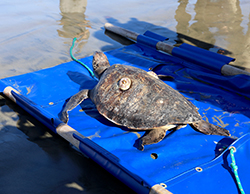
Ready for release.

Heading back out to the open water.
CDFW Senior Environmental Scientist Mike Harris is credited with the rescue of a green sea turtle that was unintentionally caught from a pier in Morro Bay.
Harris and the Morro Bay Harbor Patrol responded to a report of the hooked turtle on Aug. 17, after Harris was alerted by a friend in the area.
He arrived to find the angler had carefully secured the turtle and was waiting for help. He noticed the fishing line with a swivel was sticking out of the turtle’s mouth and determined the hook could not be easily removed.
Harris shares work space in Morro Bay with The Marine Mammal Center (TMMC) triage facility, positioning himself well for marine wildlife response. Coincidentally, the TMMC Morro Bay veterinarian is Heather Harris, Mike’s wife, who happens to be an expert on sea turtles.
“She was the first person I called,” he said.
Veterinarian Harris stabilized the turtle and determined it needed surgery since the hook was lodged deep in its throat. Not having the proper equipment and supplies for this type of surgery at the triage site, Heather reached out to colleagues at the Aquarium of the Pacific in Long Beach to arrange for the required care.
The green sea turtle was transported that afternoon and underwent surgery for the hook removal the same day. The hook was successfully removed, the turtle was provided antibiotic treatment and, after several weeks of rehabilitation, was released back into the wild on September 18th.
Harris said the rescue was made possible by the great working relationship between CDFW, TMMC, other agencies and the public.
“Over the past 20 years, I’ve built a connection with the community,” said Harris. “Whether it’s whales, dolphins or sea otters, the public and local agencies often call me to report these types of wildlife events.”
Harris has worked in the Morro Bay area for more than 27 years and is one of two sea otter biologists that work for CDFW’s Office of Spill Prevention and Response (CDFW-OSPR) Marine Wildlife Veterinary Care and Research Center (MWVCRC).
The MWVCRC is a one-of-a-kind lab built in 1997 and focuses on the rescue, rehabilitation and research of oiled marine wildlife, with emphasis on sea otters. California lawmakers created OSPR in 1991 due to several major spills including the Exxon Valdez in 1989. The lab is funded by a fee on petroleum entering California refineries.
Photos Copyright Aquarium of The Pacific. Top Photo: Rescued green sea turtle.